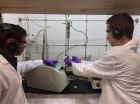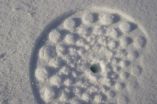(Press-News.org) AMHERST, Mass. – A team of materials chemists, polymer scientists, device physicists and others at the University of Massachusetts Amherst today report a breakthrough technique for controlling molecular assembly of nanoparticles over multiple length scales that should allow faster, cheaper, more ecologically friendly manufacture of organic photovoltaics and other electronic devices. Details are in the current issue of Nano Letters.
Lead investigator, chemist Dhandapani Venkataraman, points out that the new techniques successfully address two major goals for device manufacture: controlling molecular assembly and avoiding toxic solvents like chlorobenzene. "Now we have a rational way of controlling this assembly in a water-based system," he says. "It's a completely new way to look at problems. With this technique we can force it into the exact structure that you want."
Materials chemist Paul Lahti, co-director with Thomas Russell of UMass Amherst's Energy Frontiers Research Center (EFRC) supported by the U.S. Department of Energy, says, "One of the big implications of this work is that it goes well beyond organic photovoltaics or solar cells, where this advance is being applied right now. Looking at the bigger picture, this technique offers a very promising, flexible and ecologically friendly new approach to assembling materials to make device structures."
Lahti likens the UMass Amherst team's advance in materials science to the kind of benefits the construction industry saw with prefabricated building units. "This strategy is right along that general philosophical line," he says. "Our group discovered a way to use sphere packing to get all sorts of materials to behave themselves in a water solution before they are sprayed onto surfaces in thin layers and assembled into a module. We are pre-assembling some basic building blocks with a few predictable characteristics, which are then available to build your complex device."
"Somebody still has to hook it up and fit it out the way they want," Lahti adds. "It's not finished, but many parts are pre-assembled. And you can order characteristics that you need, for example, a certain electron flow direction or strength. All the modules can be tuned to have the ability to provide electron availability in a certain way. The availability can be adjusted, and we've shown that it works."
The new method should reduce the time nano manufacturing firms spend in trial-and-error searches for materials to make electronic devices such as solar cells, organic transistors and organic light-emitting diodes. "The old way can take years," Lahti says.
"Another of our main objectives is to make something that can be scaled up from nano- to mesoscale, and our method does that. It is also much more ecologically friendly because we use water instead of dangerous solvents in the process," he adds.
For photovoltaics, Venkataraman points out, "The next thing is to make devices with other polymers coming along, to increase power conversion efficiency and to make them on flexible substrates. In this paper we worked on glass, but we want to translate to flexible materials and produce roll-to-roll manufactured materials with water. We expect to actually get much greater efficiency." He suggests that reaching 5 percent power conversion efficiency would justify the investment for making small, flexible solar panels to power devices such as smart phones.
If the average smart phone uses 5 watts of power and all 307 million United States users switched from batteries to flexible solar, it could save more than 1500 megawatts per year. "That's nearly the output of a nuclear power station," Venkataraman says, "and it's more dramatic when you consider that coal-fired power plants generate 1 megawatt and release 2,250 lbs. of carbon dioxide. So if a fraction of the 6.6 billion mobile phone users globally changed to solar, it would reduce our carbon footprint a lot."
Doctoral student and first author Tim Gehan says that organic solar cells made in this way can be semi-transparent, as well, "so you could replace tinted windows in a skyscraper and have them all producing electricity during the day when it's needed. And processing is much cheaper and cleaner with our cells than in traditional methods."
Venkataraman credits organic materials chemist Gehan, with postdoctoral fellow and device physicist Monojit Bag, with making "crucial observations" and using "persistent detective work" to get past various roadblocks in the experiments. "These two were outstanding in helping this story move ahead," he notes. For their part, Gehan and Bag say they got critical help from the Amherst Fire Department, which loaned them an infrared camera to pinpoint some problem hot spots on a device.
It was Bag who put similar sized and charged nanoparticles together to form a building block, then used an artist's airbrush to spray layers of electrical circuits atop each other to create a solar-powered device. He says, "Here we pre-formed structures at nanoscale so they will form a known structure assembled at the meso scale, from which you can make a device. Before, you just hoped your two components in solution would form the right mesostructure, but with this technique we can direct it to that end."
INFORMATION:
This work at the Polymer-Based Materials for Harvesting Solar Energy is part of an EFRC supported by the U.S. DOE's Office of Basic Energy Sciences.
Eco-friendly 'pre-fab nanoparticles' could revolutionize nano manufacturing
UMass Amherst team invents a way to create versatile, water-soluble nano-modules
2014-08-13
ELSE PRESS RELEASES FROM THIS DATE:
What are the advantages of being married to a physician?
2014-08-13
ANN ARBOR, Mich. – Physicians tend to marry later and their marriages last longer even as they face the challenges, like others with demanding professions, of giving time and attention to their partners and families.
The University of Michigan Medical School interviewed physicians and spouses to learn how "medical marriages" succeed and the resulting report is rich with data and anecdotes about live-in in-laws, role definition, financial security and the advantage of avoiding the emergency room because Mom or Dad knows how to stitch a bad cut.
Published by the Association ...
HPV vaccine could 'close the gap' on Indigenous health
2014-08-13
In the most comprehensive assesment of its type, UNSW Australia-led research has found that in just four years, the HPV vaccine has resulted in a dramatic drop in genital warts in young Australians from a range of backgrounds, a result that could herald further good news for cervical cancer rates in future.
The research, which was done in collaboration with the University of Sydney, is based on national hospital admission rates and shows a similar result in the female Indigenous population, which has historically had significantly higher rates of cervical cancer. Genital ...
York survey highlights ocean research priorities
2014-08-13
Declines in ocean productivity, increases in ocean acidification, and the cumulative effects of multiple stressors on ocean health are among the most pressing issues facing coastal and maritime countries, according to a survey of scientists by a University of York researcher.
All three issues were ranked in the top five ocean research priorities by oceanographers and marine ecologists from around the globe, in a survey led by Dr Murray Rudd, from York's Environment Department, and reported in Frontiers in Marine Science.
The survey asked 2,197 scientists from 94 countries ...
Exercise associated with reduced risk of breast cancer in African American women
2014-08-13
(Boston)—Regular exercise, including brisk walking, is associated with a decrease in the incidence of breast cancer in African American women. In a recently published study in Cancer Epidemiology, Biomarkers & Prevention, researchers from Boston University's Slone Epidemiology Center found strong evidence linking physical exercise to a lower rate of breast cancer in African American women, a group in which previous evidence has been lacking.
In a large prospective study of the health of black women, the Black Women's Health Study (BWHS), researchers collected information ...
Pitt engineer turns metal into glass
2014-08-13
Materials scientists have long sought to form glass from pure, monoatomic metals. Scott X. Mao and colleagues did it.
Their paper, "Formation of Monoatomic Metallic Glasses Through Ultrafast Liquid Quenching," was recently published online in Nature, a leading science journal.
Mao, William, Kepler Whiteford Professor of Mechanical Engineering and Materials Science at the University of Pittsburgh, says, "This is a fundamental issue explored by people in this field for a long time, but nobody could solve the problem. People believed that it could be done, and now we're ...
Snow has thinned on Arctic sea ice
2014-08-13
From research stations drifting on ice floes to high-tech aircraft radar, scientists have been tracking the depth of snow that accumulates on Arctic sea ice for almost a century. Now that people are more concerned than ever about what is happening at the poles, research led by the University of Washington and NASA confirms that snow has thinned significantly in the Arctic, particularly on sea ice in western waters near Alaska.
A new study, accepted for publication in the Journal of Geophysical Research: Oceans, a publication of the American Geophysical Union, combines ...
New progress in long bone fracture evaluation using ultrasound
2014-08-13
A recent study illustrated that the mode conversion of the ultrasonic guided waves can quantitatively reflect the fracture degree of long cortical bone, which may provide new method for long bone fracture evaluation and healing monitoring.
This scientific paper (Quantitative evaluation of long bone fractures by ultrasonic guided waves) is published on SCIENCE CHINA Physica, Mechanica & Astronomica (in Chinese), 2014, 44(7). Professor TA De-an from school of information science and technology, Fudan university leads this study. The impacts of fracture width and depth on ...
Flexible tapes from the nanoworld
2014-08-13
Porphyrin molecules are essential to many biological processes, such as photosynthesis and respiration. Dr. Wilhelm Auwärter's group is investigating these all-round talents at TU München.
Normally, hydrogen attaches to the outer edges of the porphyrin core – named porphine, but other chemical entities can take the place of hydrogen, thereby changing the properties of the molecules.
Alissa Wiengarten, PhD student at the TUM Department of Physics, heats a porphine powder in a vacuum chamber. In the process, individual porphine molecules leave the collective and adhere ...
Teachers play key role in program to fight childhood obesity
2014-08-13
An innovative physical activities guide developed at the Frank Porter Graham Child Development Institute (FPG) is helping North Carolina fight childhood obesity. New research shows that when teachers direct these physical activities, young children become more active and less sedentary.
"In the past twenty years, childhood obesity rates have skyrocketed," said FPG investigator Allison De Marco. "And for the first time in over a century, children's life expectancies are declining because of increased numbers of overweight kids."
De Marco said these statistics are especially ...
Researchers uncover clues about how the most important TB drug attacks its target
2014-08-13
Researchers at the Johns Hopkins Bloomberg School of Public Health say they have discovered a new clue to understanding how the most important medication for tuberculosis (TB) works to attack dormant TB bacteria in order to shorten treatment.
The antibiotic Pyrazinamide (PZA) has been used to treat TB since the 1950s, but its mechanisms are the least understood of all TB drugs. The PZA findings may help researchers identify new and more effective drugs not only for TB – which can require six months or more of treatment – but other persistent bacterial infections. A report ...
LAST 30 PRESS RELEASES:
Researchers identify gene that calms the mind and improves attention in mice
Artificial metabolism turns waste CO2 into useful chemicals
Ancient sea anemone sheds light on animal cell type evolution
Begging gene leads to drone food
How climate policies that incentivize and penalize can drive the clean energy transition
Can community awareness campaigns in low-resource areas improve early diagnosis of colorectal cancer?
Stardust study resets how life’s atoms spread through space
Practical education: Clinical scenario-based program development
The impact of family dynamics on eating behaviour – how going home for Christmas can change how you eat
Tracing the quick synthesis of an industrially important catalyst
New software sheds light on cancer’s hidden genetic networks
UT Health San Antonio awarded $3 million in CPRIT grants to bolster cancer research and prevention efforts in South Texas
Third symposium spotlights global challenge of new contaminants in China’s fight against pollution
From straw to soil harmony: International team reveals how biochar supercharges carbon-smart farming
Myeloma: How AI is redrawing the map of cancer care
Manhattan E. Charurat, Ph.D., MHS invested as the Homer and Martha Gudelsky Distinguished Professor in Medicine at the University of Maryland School of Medicine
Insilico Medicine’s Pharma.AI Q4 Winter Launch Recap: Revolutionizing drug discovery with cutting-edge AI innovations, accelerating the path to pharmaceutical superintelligence
Nanoplastics have diet-dependent impacts on digestive system health
Brain neuron death occurs throughout life and increases with age, a natural human protein drug may halt neuron death in Alzheimer’s disease
SPIE and CLP announce the recipients of the 2025 Advanced Photonics Young Innovator Award
Lessons from the Caldor Fire’s Christmas Valley ‘Miracle’
Ant societies rose by trading individual protection for collective power
Research reveals how ancient viral DNA shapes early embryonic development
A molecular gatekeeper that controls protein synthesis
New ‘cloaking device’ concept to shield sensitive tech from magnetic fields
Researchers show impact of mountain building and climate change on alpine biodiversity
Study models the transition from Neanderthals to modern humans in Europe
University of Phoenix College of Doctoral Studies releases white paper on AI-driven skilling to reduce burnout and restore worker autonomy
AIs fail at the game of visual “telephone”
The levers for a sustainable food system
[Press-News.org] Eco-friendly 'pre-fab nanoparticles' could revolutionize nano manufacturingUMass Amherst team invents a way to create versatile, water-soluble nano-modules




